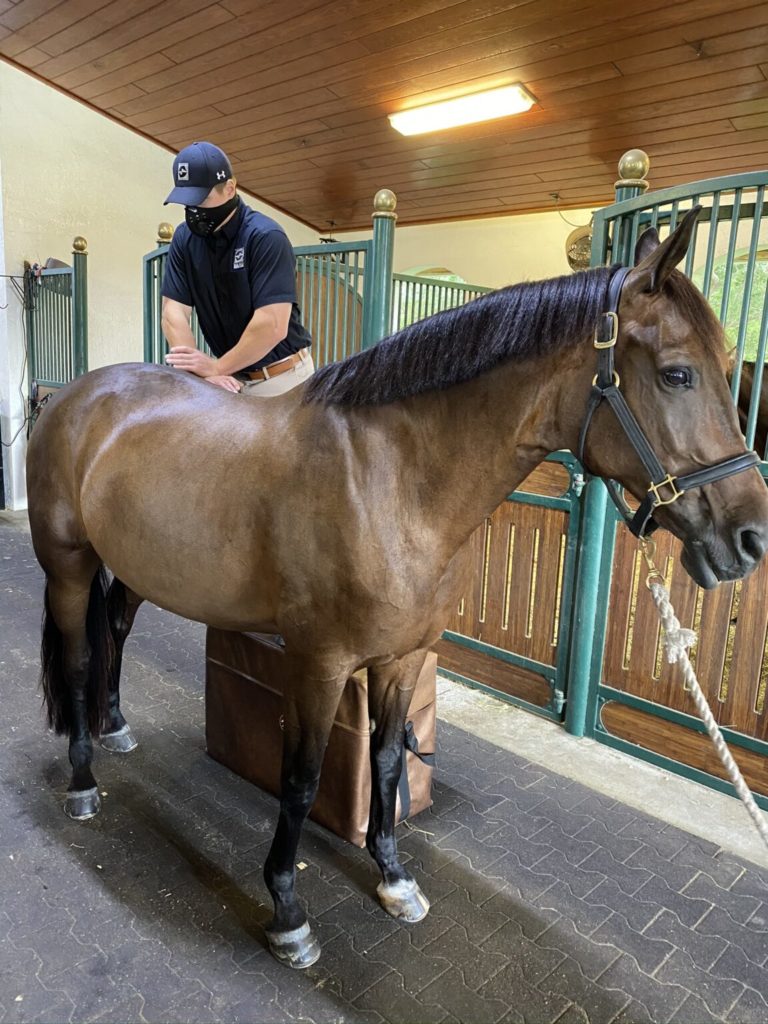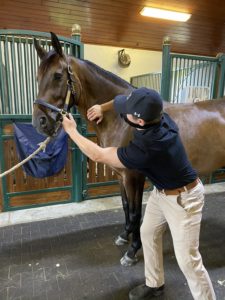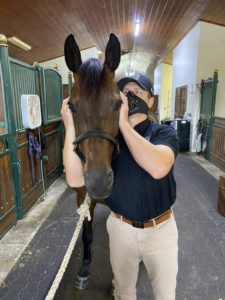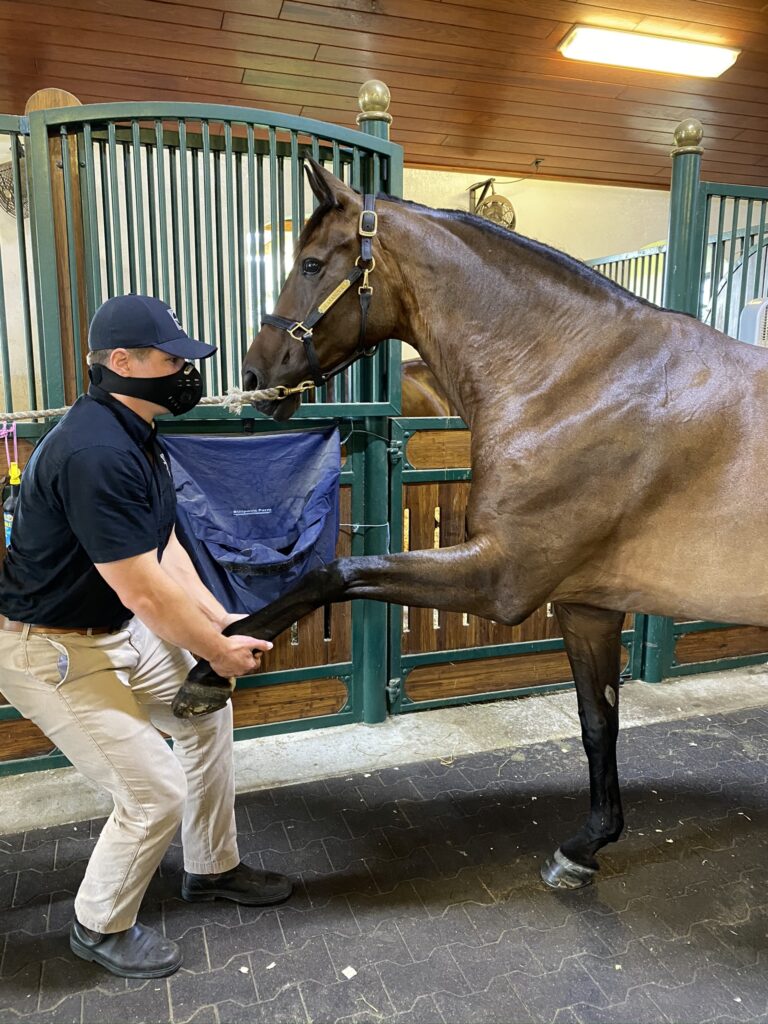Dr. Ryan Lukens of Palm Beach Equine Clinic is here to help with the basics of veterinary chiropractic work for your equine athletes. Words by Dr. Lukens/Palm Beach Equine Clinic.
Horse owners often joke that they take better care of their horses than they do themselves. While there are maintenance treatments and products that could be considered a luxury, veterinary chiropractic adjustments do not fall into that category. Palm Beach Equine Clinic veterinarian Dr. Ryan Lukens is a certified Veterinary Medical Manipulation Practitioner from the Chi Institute in Ocala, FL, and recommends every horse reap the benefits of regular chiropractic adjustments.
 Dr. Lukens works on a horse’s thoracic vertebrae. Photo courtesy PBEC.
Dr. Lukens works on a horse’s thoracic vertebrae. Photo courtesy PBEC.
From minis to draft horses and pasture pets to top sport mounts, the parasympathetic stimulation triggered by chiropractic adjustments improves multiple facets of health for any horse. Therefore, equine chiropractic adjustments improve more than just athletic performance, and for sport horses, Dr. Lukens considers them a necessity.
“One of the most beneficial outcomes of regular veterinary chiropractic adjustments is an increase in range of motion,” said Dr. Lukens. “Ensuring the horse has proper range of motion can greatly reduce the chances of them having to physically compensate for an area that may not be functioning up to par. By reducing the chances of compensation, we reduce the chances of many common sport hose injuries. Most athletic injuries occur when a horse is slightly off balance due to compensating. Regular chiropractic adjustments help horses to maintain their natural balance.”
According to Dr. Lukens, further benefits of veterinary chiropractic adjustments include:
- Relief of pain and soreness
- Reversal of muscle atrophy by increasing the frequency of nerve activation
- Increasing the speed and accuracy of athletic movement
- Adjustments help calm the “fight or flight” response. This has a domino effect of improving various bodily functions, such as neutralizing stomach acids, improving hind gut digestion, lowering blood pressure, lowering cortisol levels, and strengthening the immune system
Dr. Lukens outlines the “must know” details of an equine chiropractic adjustment for any sport horse owner. Here’s what he would like you to understand about your horse’s chiropractic adjustment.
 Adjusting the horse’s pelvis. Photo courtesy PBEC.
Adjusting the horse’s pelvis. Photo courtesy PBEC.
1. The Major Adjustment Points
I take a full body approach to every session. There are 205 bones that comprise the skeleton of a horse, however, I am not just adjusting the skeleton––I work to improve motion at segmented levels that involve bones and the supporting soft tissue structures and nerves. I was taught to use “motion palpation” to test moving segments. If a segment is not moving freely in the appropriate directional planes, I can perform an adjustment to correct the restriction of this movement.
Major adjustment points include the:
- Mandible and tongue
- Temporomandibular joint (TMJ)
- Poll and cervical vertebrae
- Withers and sternum
- Front and hind limbs
- Thoracic and lumbar vertebrae
- Pelvis/sacrum
2. Every horse is different, and their discipline of riding places different demands on their bodies.
The most common adjustments for various performance horses include:
- Dressage: Balance is essential for dressage. The major points of balance affected by veterinary chiropractic work are the TMJ, hyoid, sternum, and cervical facets. Other common adjustments affected by lateral work include the shoulders, elbows, and pelvis.
- Hunter/Jumper: Hunters and jumpers typically benefit from vertebral adjustments of the lumbar and upper cervical regions, ribs, sternum, front distal limbs, and the shoulders.
- Eventing: Most eventing horses benefit from adjustments to the pelvis, all cervical vertebrae, TMJ, ribs, and the shoulders.
- Western disciplines: Reiners benefit from adjustments to their right shoulder, lower cervical facets, withers and pelvis, and barrel racers benefit from shoulder, sacroiliac and hip joint adjustments.
 3. Things to keep in mind before and after an adjustment
3. Things to keep in mind before and after an adjustment
It is important that dental and farrier work is not overdue before veterinary chiropractic adjustments. Sharp dental points can cause adjustments to hold for shorter periods of time, especially in the poll, TMJ, and cervical vertebrae. In addition, if a horse is currently not shod well or has recently pulled a shoe, the adjustments of their limbs, back, pelvis and sacrum may not provide long lasting benefits.
Besides those prerequisites, a horse can be ridden before an appointment and have a normal day. The only restriction on riding is that they should not be ridden for the remainder of the day after the adjustment. However, they may be turned out to pasture after an adjustment. The following day, I encourage that the horse be ridden as normal and that the owner or rider follow up with me about how they felt.
I prefer to see new patients two weeks after their initial adjustment appointment. After the second appointment, I sit down with the rider to discuss and compare the chiropractic adjustments performed between the two sessions. If I made multiple of the same adjustments, their appointment intervals will stay at every two weeks. Once there is a decrease in similar adjustments, I can increase the time interval between sessions to three weeks. Some horses can maintain the adjustments for about four to six weeks when under lighter work. The rider can usually feel when a horse is due for another adjustment. As a rule, high-level performance horse can benefit from chiropractic adjustments as often as every week, but the most common interval for my clients at that level is every other week.
 4. Chiro to the Rescue! Common Issues
4. Chiro to the Rescue! Common Issues
I often see some common issues solved by a veterinary chiropractic adjustment. For jumpers, changes in jumping style (i.e. landing away from a front limb, only jumping off of a certain lead) and performance (hitting more rails than normal) could indicate a lack of range of motion, which can be corrected through a proper adjustment or series of adjustments.
For dressage horses, a change in their balance could result in head tilting, not becoming round through their back, lifting the lower cervical curve, or their hind limbs not following the path of the front limbs, and commonly seen in a new inability to perform tempi changes. That balance can be reestablished with an adjustment.
For western horses, a decrease in acceleration and turning can be indicative of needing adjustments.
5. How to choose your equine chiropractor
The Chi Institute in Ocala, FL, trains only licensed veterinarians in medical manipulations (chiropractic adjustments). I believe that a veterinarian trained in chiropractic adjustments is the safest choice for the horse. A veterinarian’s extensive knowledge of anatomy and understanding of when not to adjust a horse is an important part of ensuring the horse’s safety and well-being. If done improperly, adjustments can have adverse effects. I received my certification (CVMMP, or Certified Veterinary Medical Manipulation Practitioner) in 2017 and have had great success in implementing chiropractic adjustments into my patients’ athletic successes.
 Adjusting a horse’s shoulder. Photo courtesy PBEC.
Adjusting a horse’s shoulder. Photo courtesy PBEC.
To learn more about veterinary chiropractic adjustments or to schedule an evaluation for your horse, contact Dr. Lukens at Palm Beach Equine Clinic by clicking here or calling +1 (561) 793-1599.
All photos courtesy PBEC.
